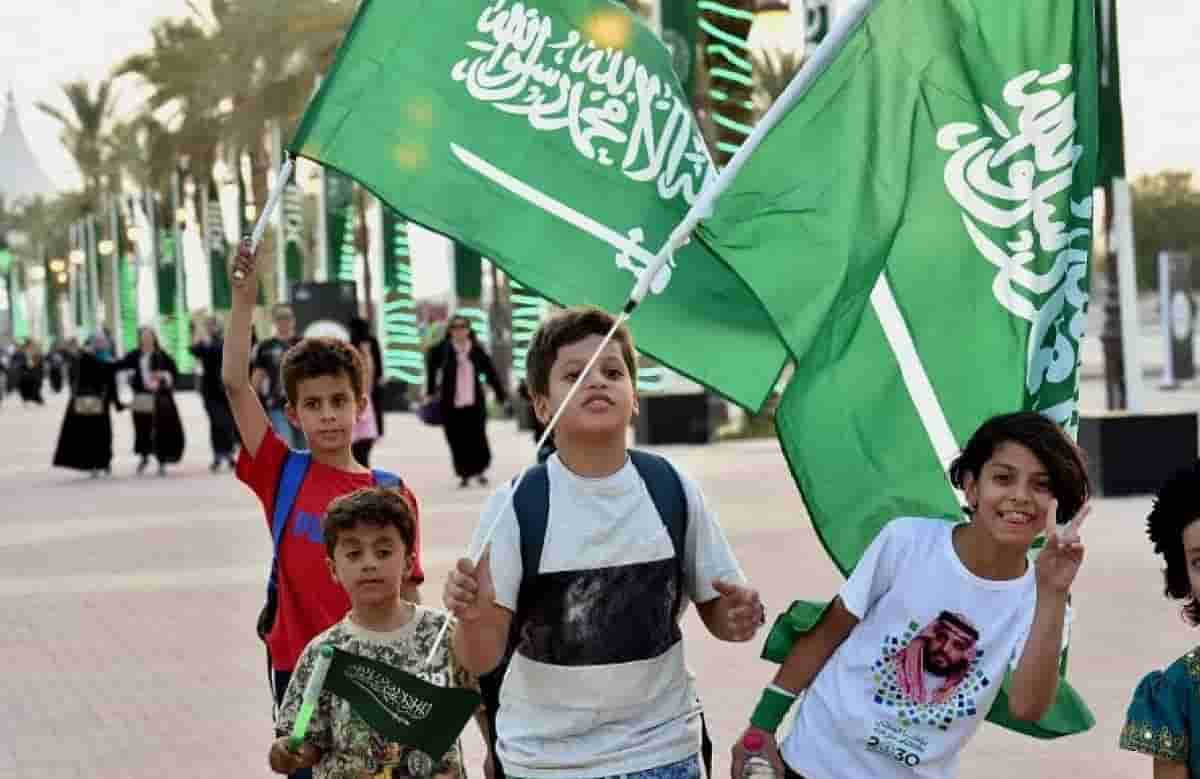Saudi Arabia to witness Saudi Flag Day celebration on 11th March for the first time in its History
Saudi Arabia to witness Saudi Flag Day celebration on 11th March for the first time in its history. King Salman, the Custodian of the Two Holy Mosques, declared March 11 of each year as a special day to celebrate the national flag by royal order on March 1.
From the establishment of the Saudi state in 1727, the national flag of the Kingdom of Saudi Arabia has represented for strength, sovereignty, and national unity. The flag has served as a symbol, shield, banner, and testimony of the Saudi state’s unity campaigns for almost three centuries. Read : King Salman announces 11th March of every year as Saudi Flag Day
– The Imams of the first Saudi kingdom, who established the state and united its lands, are credited with creating the history of the Saudi Arabian flag. ” There is no god but Allah, and Muhammad is the Messenger of Allah”, read the green banner that was placed on a wooden pole.
– Throughout the first and second Saudi states, the flag remained true to these requirements. During a crucial period of King Abdulaziz’s rule, when he led the drive for the country’s unification, security, and welfare, two crossed swords were placed to the flag.
– Later, the sword was changed from having two swords to just one. The Islamic tenet “There is no god but Allah, Muhammad is the Messenger of Allah” was then placed above the sword. The flag’s design eventually came to include the words “monotheism” and a drawn sword below.
– Before the Shoura Council made a suggestion to King Abdulaziz, who on March 11, 1937 AD approved the final design, the flag’s shape, coordination, and elements were all passed down orally ( Dhul-Hijjah 27, 1355 AH). The implementation of the Saudi Flag Bylaw comes in 1393 AH (1973 AD). Recommend : Download Digital Iqama
– According to the bylaw, the Saudi Arabian flag must be rectangular, have a width that is equivalent to two-thirds of its length, and be green from the pole to its edge. At the center, the words “There is no god but Allah, and Muhammad is the Messenger of Allah” are written. Below the words of monotheism printed in Thuluth script is a drawn sword with its grip pointed at the base of the flag.
– From both sides, it is easy to see the sword and the creed because they are both white. The sword is at a length equal to three-quarters of the monotheistic testimony and is equally spaced from both sides from the flag’s base, which is positioned in the center of the word’s width.
– Each of the slogans and colors has significant meaning. White denotes purity and peace, green represents growth and fertile soil, and the sword stands for security and justice. This sword symbolism has Arab roots and is a representation of Arab strength and royalty. The concept of monotheistic serves as evidence for the Oneness of Allah and the proper implementation of His Shariah (Islamic law), which the Kingdom established and has kept to throughout its three stages of development.
– The Saudi flag stands out among other flags because it has distinctive qualities that give it a sense of awe, respect, and glorification. The flag is not allowed to be placed over the bodies of kings or others, it is not lowered at half-mast at sad events, and it is not bowed to visitors who view the guard of honor. Story : Countries around Saudi Arabia
– When it is required to do so at a time of sorrow, the flag is raised by placing it in the center of the column upside-down and without the phrase “monotheism” for a predetermined amount of time. It is not allowed to be used as a trademark or in advertisements because doing so would damage its reputation.
– The national flag is flown atop all government structures, public institutions, and the Kingdom’s diplomatic missions overseas, even on days off. Only when the flag is in good condition and in accordance with established international procedure may it be flown. Use of the flag while it is damaged is not permitted. The flag is given to the official authorities to burn in a certain way if its color has faded or if it is going to be destroyed.
– The Saudi flag has always flown proudly and still does. Because it reflects the principles of the nation and the faith, the environment and the land, as well as the unity that the Kingdom of Saudi Arabia represents on the Arabian Peninsula, it has a distinct meaning that distinguishes it from other flags.
– A royal decree was issued on Shaban 09, 1444 AH, which is equivalent to March 01, 2023, designating March 11 of every year to be a special day to commemorate the flag under the name “The Flag Day (Saudi Flag Day)”, because the Founder, the late King Abdulaziz, approved the flag in its current shape on Dhul-Hijjah 27, 1355 AH, which corresponds to March 11, 1937, and because of the significance of its symbols, which stand for monotheism, justice, strength, development, and prosperity. Like and Follow Saudi Expatriates on Facebook
– The Saudi Flag Day belief stems from the government of the Custodian of the Two Holy Mosques, King Salman bin Abdulaziz and the Crown Prince, who believe that the flag has great significance as a manifestation of the Saudi state, its strength, and sovereignty and cohesion.
